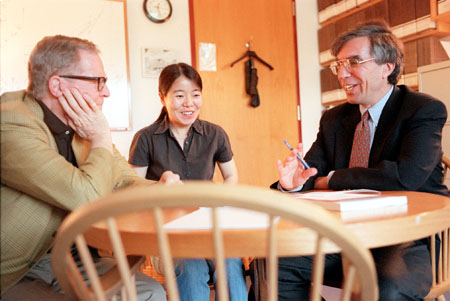Program connects environmental dots

What will it cost corporations to reduce the sulfur emissions that lead to acid rain? What incentives will spur consumers to conserve water?
According to Robert Stavins, Albert Pratt Professor of Business and Government at the Kennedy School of Government, Harvard is the best place in the world to answer these questions. The University boasts a breadth and depth of faculty interest in the field of environmental economics that is unequalled, he says.
But because Harvard’s environmental economics expertise is spread across the faculties of several schools, faculty members were, until recently, often unaware of their colleagues’ work in the field. Graduate students, who studied the subject in four different schools, were not tapping the diversity of faculty resources.
“We were not exploiting the economies of scope and the economies of scale that we have,” says Stavins, speaking like the economist he is.
The new Environmental Economics Program (EEPHU), which Stavins directs, is working to overcome this lack of connection by creating synergy among the scholars at Harvard who work in this field. Launched in winter 2001, the EEPHU brings together 17 faculty members from six schools (Faculty of Arts and Sciences, Kennedy School of Government, Business School, Law School, School of Design, and School of Public Health) and 12 predoctoral fellows from four doctoral programs: economics, public policy, political economy and government, and health policy.
As a field, environmental economics addresses the ongoing struggle between fueling the economy and protecting the environment. “The causes of environmental problems are fundamentally economic,” says Stavins. “They’re a natural consequence of a market economy.” Environmental issues making headlines – global warming, acid rain, Arctic oil exploration – are rooted in economic behavior. “This is a tremendous growth area. Demand is much greater than the supply of environmental economics Ph.D.s,” he says.
The Environmental Economics Program, jointly sponsored by the Center for Business and Government at the Kennedy School of Government and the University Center for the Environment, is not a degree-granting program. Rather, “it provides a venue for these faculty members to get to know one another, to work together, and to provide greater services to graduate students,” says Stavins, adding that it also helps graduate students studying the subject in different departments connect to each other.
Toward this end, predoctoral fellows gather weekly for a research lunch seminar. At a regular seminar in environmental economics, academics and policy-makers from around the world present research.
Another key component of the EEPHU is the program’s Web site – www.ksg.harvard.edu/cbg/eephuhome.htm – which brings together the University’s rich resources in environmental economics under one virtual roof. Stavins says that the Web site, featuring research issues and faculty and student profiles, is a great resource for students and potential students interested in the field.
To an external audience of media, policy-makers, and scholars, the program and the Web site “raise the visibility of Harvard as a center of scholarship in the area of environmental economics,” Stavins says. “These 17 faculty members are world-class scholars and leaders in their particular areas. But we’re not all in one place, so that critical mass is often not observed by the outside world as being as significant as it is.”
Inspiration for this program came in part from Stavins’ own experience pursuing a Ph.D. at Harvard. Although he is quick to point out that he got an excellent education in economics, Stavins was unaware of faculty or students in other parts of the University who were also working on environmental economic questions.
Lori Snyder, a predoctoral fellow in public policy, is reaping the fruits of Stavins’ experience. “Before I began working with the Environmental Economics Program, I was aware of only a small fraction of the research being conducted at Harvard at the intersection of economics and environmental policy,” says Snyder, who is also the EEPHU program coordinator and overseer of the Web site. For her dissertation, she is researching how information-based environmental regulations such as the Toxic Release Inventory affect firms’ decisions on input use, production levels, and emissions.
For Joe Aldy, a Ph.D. student in economics studying the relationship between environmental regulation and technological innovation, developing a peer group across departments has proved valuable. “These are the people we’ll be collaborating with and reading about throughout our careers,” he says. This summer, Aldy will work with Kip Viscusi, John F. Cogan Jr. Professor of Law and Economics at Harvard Law School, doing research on Superfund sites.
Other research in the program represents the breadth of the field of environmental economics. Sheila Cavanagh, a public policy student, recently received a National Science Foundation grant with Stavins for her dissertation work on the effectiveness of various policy instruments in managing urban water scarcity, in the context of the effects of global climate change on regional water supplies. Political economy and government student Ruben Lubowski spent two years in Sri Lanka studying the use of nontimber rainforest products by local communities; for his dissertation, he is conducting an econometric study of land-use changes in the United States to estimate the costs of removing carbon dioxide from the atmosphere through reducing deforestation.
Stavins is confident that the EEPHU will continue to grow and attract high-quality scholarship to Harvard. As the program moves forward, he says, the faculty will look at curriculum in environmental economics University-wide, evaluating unmet needs and expanding accordingly. Calls from other universities interested in starting similar programs – University of California, Berkeley, Yale, and Duke among them – speak to the scholarly interest in environmental economics.
But Stavins only needs to look around him to see that the EEPHU is on the right track. “I’m gratified to see faculty members communicating and discussing issues,” he says. And he gets “great satisfaction when I realize that graduate students are going to be getting a much better education because of it.”
Contact Beth Potier at beth_potier@harvard.edu




